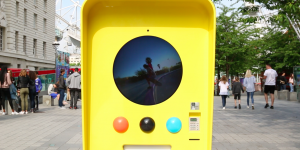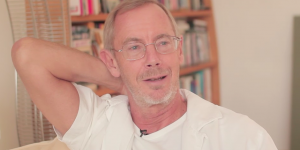The social media strategy at Santander UK isn’t concerned with fan growth or sharing a quirky promotional post. Instead, the focus is on understanding how people might bank on social networks that command more of their time online.
Likes, retweets and followers might be the gauge of a successful social media campaign to some marketers but for Keith Moor they are unnecessary. To Santander UK’s chief marketing officer, success is more about what are the experiences people are having within a particular channel and “much less about fan growth”.
Teens now spend up to nine hours a day on social platforms, according to Global Web Index, while 30% of all time spent online is now allocated to social media interaction. So, if a person is more likely to be on Facebook when they need to check their account, then Santander wants to be the bank that lets them do that.
It “really won’t be just about social channels being places where people go to do ‘social stuff’,” says Moor of why this shift is so important for the bank. “They’re living their lives through those platforms and so we need to be in those places too,” he continues. “Why would someone bother coming out of an app when they can do most of their stuff within the app experience. We need to be part of that ecosystem.”
How Santander does this is still being mapped out and Moor admits there will be mistakes along the way. However, with social media budgets on the up at the bank thanks to redirected funds from print, the senior marketer wants the medium to play a bigger role in driving customer loyalty. Customer growth “isn’t really a primary focus” for the financial firm, which is why Moor won’t splash the cash on promotional posts and big social media campaigns to raise awareness. Rather, he sees Santander’s money going on chatbots, social banking and other services that could fit seamlessly into the way people behave on social networks.
Social media is not a promotional strategy at Santander, it’s about understanding what ‘punters’ want online
Whether someone is transferring money, paying a credit card bill or voicing their frustrations about certain services, knowing what features to offer customers and where requires more than just a bigger budget. It’s why Moor has recruited more people into the team to work on social media. Over time, he envisages a team bereft of social media experts for one where the responsibility for it is shared by all his marketers. By that same notion, he argues that the agencies he works with will have to treat the medium as a standard part of what they offer. “I want the agencies I’m working with – my main strategic partners – to have social baked into the heart of what they’re doing,” he demands. “And so that’s why in the teams that we have at Engine as well as Dentsu and Carat, the social infrastructure is part of the main team and isn’t a little bit on the side”.
Compliance, security and privacy will be top of mind for both brand and agencies’ attempt to balance the need to protect people’s money with making them feel more empowered. Moor hints at the scale of the challenge ahead when talking about why Santander has been coy to move into mobile messaging. The rewards of having such a personalized dialogue with a customer are clear but so too is the security risk should the correct policies not be in place.
There’s “not much opportunity to use them [mobile messaging apps] now,” admits Moor. “Having said that we do have to find a way to exist on platforms like WhatsApp. The problem for us is the security angle; for banks that’s a big red herring. Many of the apps have a two-stage identification process and we need a bit more security than perhaps if someone were to buy a coat for example. People are very conscious of being secure with their money. It’s a fundamental part of what people like to keep private so we have to weight that up against people’s desire to do things in a more convenient manner.”
Changes on this scale will inevitably mean Santander ‘in-houses’ more of what it once briefed out to agencies. Yet, Moor is adamant this will help both brand and agency for the better even though some observers might argue it’s merely a chance to shave further costs amidst downward pressure on marketing budgets.
“My [marketing] budget hasn’t grown over the last few years, if anything it’s gone down like most marketers’ budgets have,” admits Moor. Effectively, Santander only does “TV advertising, digital and social” now, he continues.
The reason “why [social media] gets more money is because we can prove that the engagement levels are versus other channels and opportunities where perhaps you’re perceiving that a lot of people are getting our messages but maybe they’re not and you can’t tell which ones and which ones aren’t,” he continues.
As true as it might be that Santander can show the effectiveness of social media, it is still a way from knowing the real value of its efforts on the likes of Facebook and Twitter. Traditional media equivalency measures won’t cut it moving forward, explains Moor, who believes it will come down to untangling the reams of data he says social platforms will share. Santander is getting to the point “where we need to understand the real value of doing something [on social media], he adds. “It’s no good, for arguments sake, going ‘I can get reach easily on here versus over there’. That doesn’t really matter. What I need to know is do my customers like me more? Do they feel happier with us? And do they want to stay longer as a result of the interactions they’re having”.
Moor didn’t offer much more as to how this will be achieved, in part because the business is still getting its head around measurement. Sales won’t be an indicator because banks “are never going to see a massive growth in sales directly off channels”.
The promise of better measurement becomes all the more important amid the advent of so-called ‘open banking’, whereby banks will have to share data that they have historically held. The rationale behind the Open Banking Standard is that the customer experience should improve as a result of the data being used to build better applications and resources. Moor agrees, though admits there will be challenges ahead.
The challenge of customer loyalty in the era of Open Banking
"I think open banking and its philosophy makes it all the more important that you have a strong relationship with the customer so that you’re front of mind when they’re thinking about finance,” he adds.
"And actually the more that you can work within the places where they’re living their lives then the more they’ll see that as being a good thing. I think banks almost have to let go a little bit to keep growing that trust."
Any progress Santander does make over the next year will have something to do with its partnership with social media management platform Sprinklr. A deal between brand and marketing tech platform was brokered after the former set up social command center several years ago. Since then it has gone on to form the backbone of its customer experience management plan. The setup means Moor and his team can access data on the fly, whether that’s brand health checks as well as unearthing potential reputational or operational risks.
Such is the importance of the union that Moor views the data as the “key to unlocking everything”. The “next stage of the journey”, he continues, is how the bank develops “customer experiences through the social platforms”.
Beyond social media, the senior marketer offered a glimpse into the bank’s wider strategy. While it’s common for marketers to wax lyrical about the trials and tribulations of navigating a tricky media supply chain in the wake of the landmark speech from Procter & Gamble’s top marketer Marc Pritchard, Moor was campaigning for similar standards before it become the industry du jour. So much so that he worked with the bank’s lead media strategist Daniel Creed to create the role several years ago and the two have been worked in tandem to introduce everything from whitelists to their own viewability standards.
“We didn’t go to the agency and say ‘stick with these rules’, we sat down with them and we asked ‘what kind of rules can we set ourselves to feel confident,” Moor adds.
“It’s one of the reasons why we still appear on Google’s platforms [despite the brand boycott of YouTube]. We’re not an advertiser who has withdrawn from those platforms. We’ve adjusted our spend so we can be sure we’re being safe but I’m not a great believer in pulling things off and threatening people with a big stick.”





















